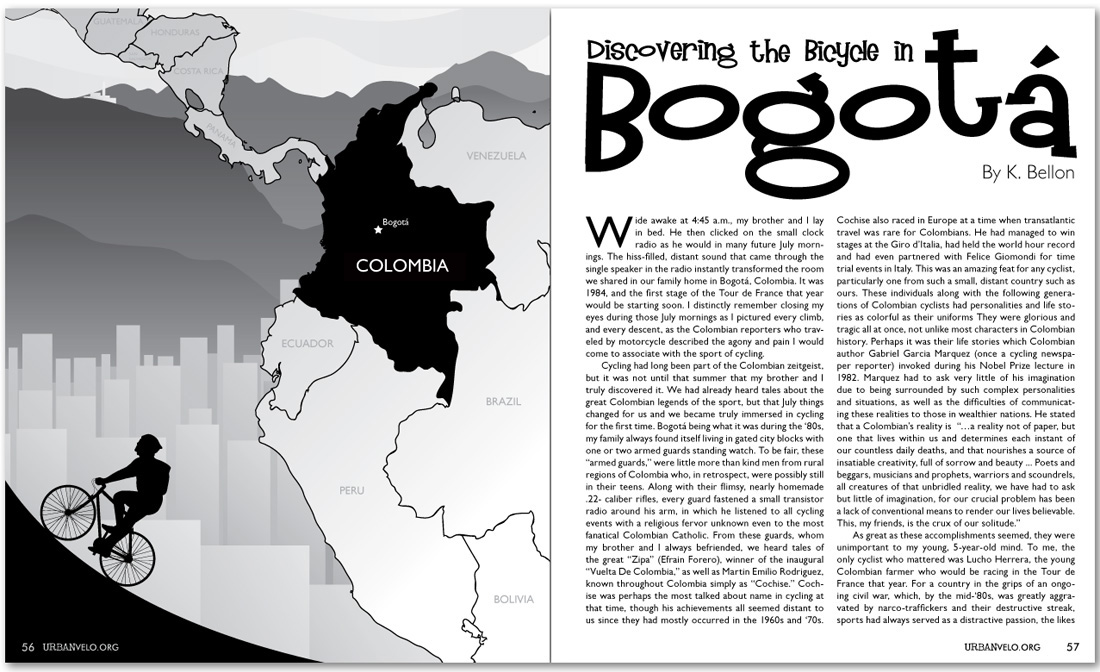|
Discovering the Bicycle in Bogotá
By K. Bellon
Wide awake at 4:45 a.m., my brother and I lay in bed. He then clicked on the small clock radio as he would in many future July mornings. The hiss-filled, distant sound that came through the single speaker in the radio instantly transformed the room we shared in our family home in Bogotá, Colombia. It was 1984, and the first stage of the Tour de France that year would be starting soon. I distinctly remember closing my eyes during those July mornings as I pictured every climb, and every descent, as the Colombian reporters who traveled by motorcycle described the agony and pain I would come to associate with the sport of cycling.
Cycling had long been part of the Colombian zeitgeist, but it was not until that summer that my brother and I truly discovered it. We had already heard tales about the great Colombian legends of the sport, but that July things changed for us and we became truly immersed in cycling for the first time. Bogotá being what it was during the ‘80s, my family always found itself living in gated city blocks with one or two armed guards standing watch. To be fair, these “armed guards,” were little more than kind men from rural regions of Colombia who, in retrospect, were possibly still in their teens. Along with their flimsy, nearly homemade .22- caliber rifles, every guard fastened a small transistor radio around his arm, in which he listened to all cycling events with a religious fervor unknown even to the most fanatical Colombian Catholic. From these guards, whom my brother and I always befriended, we heard tales of the great “Zipa” (Efrain Forero), winner of the inaugural “Vuelta De Colombia,” as well as Martin Emilio Rodriguez, known throughout Colombia simply as “Cochise.” Cochise was perhaps the most talked about name in cycling at that time, though his achievements all seemed distant to us since they had mostly occurred in the 1960s and ‘70s. Cochise also raced in Europe at a time when transatlantic travel was rare for Colombians. He had managed to win stages at the Giro d’Italia, had held the world hour record and had even partnered with Felice Giomondi for time trial events in Italy. This was an amazing feat for any cyclist, particularly one from such a small, distant country such as ours. These individuals along with the following generations of Colombian cyclists had personalities and life stories as colorful as their uniforms They were glorious and tragic all at once, not unlike most characters in Colombian history. Perhaps it was their life stories which Colombian author Gabriel Garcia Marquez (once a cycling newspaper reporter) invoked during his Nobel Prize lecture in 1982. Marquez had to ask very little of his imagination due to being surrounded by such complex personalities and situations, as well as the difficulties of communicating these realities to those in wealthier nations. He stated that a Colombian’s reality is “…a reality not of paper, but one that lives within us and determines each instant of our countless daily deaths, and that nourishes a source of insatiable creativity, full of sorrow and beauty ... Poets and beggars, musicians and prophets, warriors and scoundrels, all creatures of that unbridled reality, we have had to ask but little of imagination, for our crucial problem has been a lack of conventional means to render our lives believable. This, my friends, is the crux of our solitude.”
As great as these accomplishments seemed, they were unimportant to my young, 5-year-old mind. To me, the only cyclist who mattered was Lucho Herrera, the young Colombian farmer who would be racing in the Tour de France that year. For a country in the grips of an ongoing civil war, which, by the mid-‘80s, was greatly aggravated by narco-traffickers and their destructive streak, sports had always served as a distractive passion, the likes
continued
|
|
|

